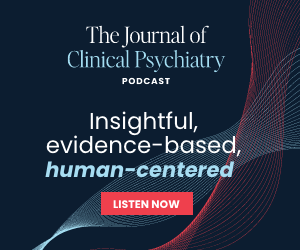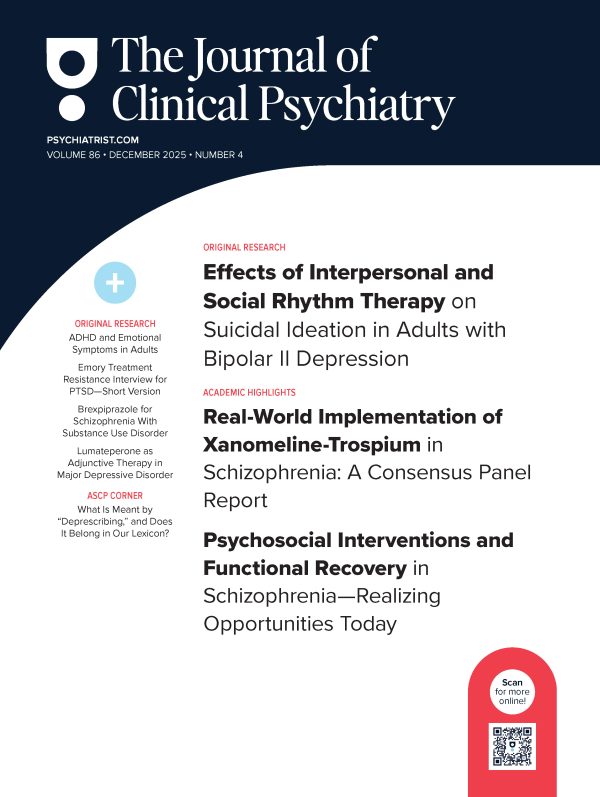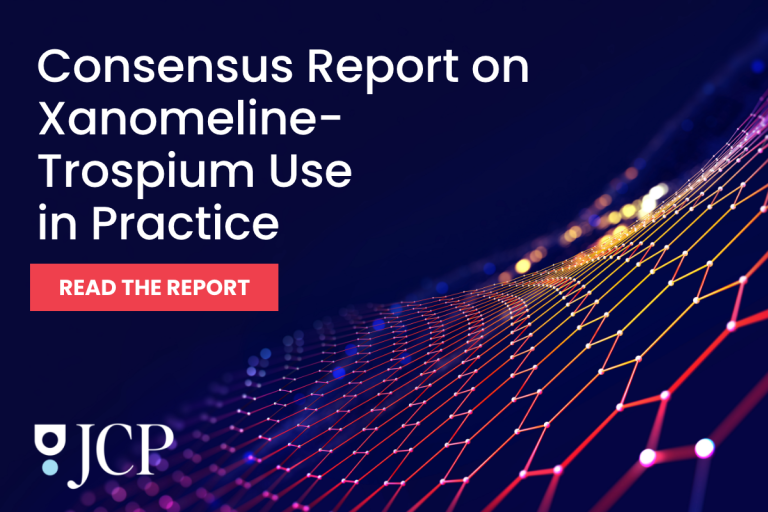ABSTRACT
Objective: Studies suggest that people with major depressive disorder (MDD) often receive treatment that is not concordant with practice guidelines. To evaluate this, we (1) developed a guideline concordance algorithm for MDD pharmacotherapy (GCA-8), (2) scored it using clinical data, and (3) compared its explanation of patient-reported symptom severity to a traditional concordance measure.
Methods: This study evaluated 1,403 adults (67% female, 85% non-Hispanic/Latino White, mean age 43 years) with non-psychotic MDD (per ICD-10 codes), from the Penn State Psychiatry Clinical Assessment and Rating Evaluation System (PCARES) registry (visits from February 1, 2015, to April 13, 2021). We (1) scored 1-year concordance using the Canadian Network for Mood and Anxiety Treatments (CANMAT) guidelines and deviation from 8 pharmacotherapy-related criteria and (2) examined associations between concordance and Patient Health Questionnaire depression module (PHQ-9) scores.
Results: The mean GCA-8 score was 6.37 (standard deviation [SD] = 1.30; 8.00 = perfect concordance). Among those who switched drugs (n = 671), 81% (n = 542) did not have their dose increased to the recommended maximum before switching. In our adjusted analyses, we found that a 1 SD increase in the GCA-8 was associated with a 0.78 improvement in the mean PHQ-9 score (P < .001). The comparison concordance measure was not associated with the mean PHQ-9 score (β = −0.20; P = .20; R2 = 0.53), and adding the GCA-8 score significantly improved the model (R2 = 0.54; Vuong test P = .008).
Conclusions: By measuring naturalistic MDD pharmacotherapy guideline concordance with the GCA-8, we revealed potential treatment gaps and an inverse association between guideline concordance and MDD symptom severity.
J Clin Psychiatry 2024;85(1):23m14916
Author affiliations are listed at the end of this article.
Major depressive disorder is a serious mental illness. Doctors use guidelines to select the best treatment options for depression. This study created a new score to measure guideline adherence. Compared to older methods, the new score has a stronger connection to symptoms. These results help identify ways to improve the guidelines and patient care.
Members Only Content
This full article is available exclusively to Professional tier members. Subscribe now to unlock the HTML version and gain unlimited access to our entire library plus all PDFs. If you’re already a subscriber, please log in below to continue reading.
References (58)

- Institute for Health Metrics and Evaluation (IHME). GBD Compare Data Visualization. IHME, University of Washington. Published 2020. Accessed March 26, 2023. https://vizhub.healthdata.org/gbd-compare
- Hammer-Helmich L, Haro JM, Jönsson B, et al. Functional impairment in patients with major depressive disorder: the 2-year PERFORM study. Neuropsychiatr Dis Treat. 2018;14:239–249. PubMed CrossRef
- Greenberg PE, Fournier AA, Sisitsky T, et al. The economic burden of adults with major depressive disorder in the United States (2010 and 2018). PharmacoEconomics. 2021;39(6):653–665. PubMed CrossRef
- Severe J, Greden JF, Reddy P. Consequences of recurrence of major depressive disorder: is stopping effective antidepressant medications ever safe? Focus Am Psychiatr Publ. 2020;18(2):120–128. PubMed CrossRef
- Thase ME, Mahableshwarkar AR, Dragheim M, et al. A meta-analysis of randomized, placebo-controlled trials of vortioxetine for the treatment of major depressive disorder in adults. Eur Neuropsychopharmacol. 2016;26(6):979–993. PubMed CrossRef
- Saragoussi D, Touya M, Haro JM, et al. Factors associated with failure to achieve remission and with relapse after remission in patients with major depressive disorder in the PERFORM study. Neuropsychiatr Dis Treat. 2017;13:2151–2165. PubMed CrossRef
- Carrasco JL, Kornstein SG, McIntyre RS, et al. An integrated analysis of the efficacy and safety of desvenlafaxine in the treatment of major depressive disorder. Int Clin Psychopharmacol. 2016;31(3):134–146. PubMed CrossRef
- Liebowitz MR, Yeung PP, Entsuah R. A randomized, double-blind, placebo-controlled trial of desvenlafaxine succinate in adult outpatients with major depressive disorder. J Clin Psychiatry. 2007;68(11):1663–1672. PubMed CrossRef
- DeMartinis NA, Yeung PP, Entsuah R, et al. A double-blind, placebo-controlled study of the efficacy and safety of desvenlafaxine succinate in the treatment of major depressive disorder. J Clin Psychiatry. 2007;68(5):677–688. PubMed CrossRef
- Fournier JC, DeRubeis RJ, Hollon SD, et al. Antidepressant drug effects and depression severity: a patient-level meta-analysis. JAMA. 2010;303(1):47–53. PubMed CrossRef
- Leucht S, Hierl S, Kissling W, et al. Putting the efficacy of psychiatric and general medicine medication into perspective: review of meta-analyses. Br J Psychiatry. 2012;200(2):97–106. PubMed CrossRef
- Gaynes BN, Rush AJ, Trivedi MH, et al. The STAR*D study: treating depression in the real world. Cleve Clin J Med. 2008;75(1):57–66. PubMed CrossRef
- Rush AJ, Trivedi MH, Wisniewski SR, et al. Acute and longer-term outcomes in depressed outpatients requiring one or several treatment steps: a STAR*D report. Am J Psychiatry. 2006;163(11):1905–1917. PubMed CrossRef
- Kennedy SH, Andersen HF, Thase ME. Escitalopram in the treatment of major depressive disorder: a meta-analysis. Curr Med Res Opin. 2009;25(1):161–175. PubMed CrossRef
- Thase ME, Nierenberg AA, Vrijland P, et al. Remission with mirtazapine and selective serotonin reuptake inhibitors: a meta-analysis of individual patient data from 15 controlled trials of acute phase treatment of major depression. Int Clin Psychopharmacol. 2010;25(4):189–198. PubMed CrossRef
- Rush AJ, Trivedi M, Carmody TJ, et al. One-year clinical outcomes of depressed public sector outpatients: a benchmark for subsequent studies. Biol Psychiatry. 2004;56(1):46–53. PubMed CrossRef
- Hengartner MP. How effective are antidepressants for depression over the long term? A critical review of relapse prevention trials and the issue of withdrawal confounding. Ther Adv Psychopharmacol. 2020;10:2045125320921694. PubMed CrossRef
- Singh JB, Fedgchin M, Daly EJ, et al. A double-blind, randomized, placebo-controlled, dose-frequency study of intravenous ketamine in patients with treatment-resistant depression. Am J Psychiatry. 2016;173(8):816–826. PubMed CrossRef
- Fava M, Davidson KG. Definition and epidemiology of treatment-resistant depression. Psychiatr Clin North Am. 1996;19(2):179–200. PubMed CrossRef
- Lundberg J, Cars T, Lööv SÅ, et al. Association of treatment-resistant depression with patient outcomes and health care resource utilization in a population-wide study. JAMA Psychiatry. 2023;80(2):167–175. PubMed CrossRef
- Perlis RH. Abandoning personalization to get to precision in the pharmacotherapy of depression. World Psychiatry. 2016;15(3):228–235. PubMed CrossRef
- Simon GE, Perlis RH. Personalized medicine for depression: can we match patients with treatments? Am J Psychiatry. 2010;167(12):1445–1455. PubMed CrossRef
- Simon G. Choosing a first-line antidepressant: equal on average does not mean equal for everyone. JAMA. 2001;286(23):3003–3004. PubMed CrossRef
- Cipriani A, Furukawa TA, Salanti G, et al. Comparative efficacy and acceptability of 21 antidepressant drugs for the acute treatment of adults with major depressive disorder: a systematic review and network meta-analysis. Lancet. 2018;391(10128):1357–1366. PubMed CrossRef
- van Bronswijk SC, DeRubeis RJ, Lemmens LHJM, et al. Precision medicine for long-term depression outcomes using the Personalized Advantage Index approach: cognitive therapy or interpersonal psychotherapy? Psychol Med. 2021;51(2):279–289. PubMed CrossRef
- Cipriani A, Geddes J. Predicting treatment outcome in depression: so far, so good. Lancet Psychiatry. 2016;3(3):192–194. PubMed CrossRef
- Deshauer D, Moher D, Fergusson D, et al. Selective serotonin reuptake inhibitors for unipolar depression: a systematic review of classic long-term randomized controlled trials. CMAJ. 2008;178(10):1293–1301. PubMed CrossRef
- Turner EH, Matthews AM, Linardatos E, et al. Selective publication of antidepressant trials and its influence on apparent efficacy. N Engl J Med. 2008;358(3):252–260. PubMed CrossRef
- Driessen E, Hollon SD, Bockting CLH, et al. Does publication bias inflate the apparent efficacy of psychological treatment for major depressive disorder? a systematic review and meta-analysis of US National Institutes of Health-funded trials. PLoS One. 2015;10(9):e0137864. PubMed CrossRef
- Gabriel FC, de Melo DO, Fráguas R, et al. Pharmacological treatment of depression: a systematic review comparing clinical practice guideline recommendations. PLoS One. 2020;15(4):e0231700. doi:10.1371/journal.pone.0231700
- Zafra-Tanaka JH, Goicochea-Lugo S, Villarreal-Zegarra D, et al. Characteristics and quality of clinical practice guidelines for depression in adults: a scoping review. BMC Psychiatry. 2019;19(1):76. PubMed CrossRef
- Malmivaara A. Generalizability of findings from randomized controlled trials is limited in the leading general medical journals. J Clin Epidemiol. 2019;107:36–41. PubMed CrossRef
- Blanco C, Olfson M, Goodwin RD, et al. Generalizability of clinical trial results for major depression to community samples: results from the National Epidemiologic Survey on Alcohol and Related Conditions. J Clin Psychiatry. 2008;69(8):1276–1280. PubMed CrossRef
- van der Lem R, de Wever WW, van der Wee NJ, et al. The generalizability of psychotherapy efficacy trials in major depressive disorder: an analysis of the influence of patient selection in efficacy trials on symptom outcome in daily practice. BMC Psychiatry. 2012;12(1):192. PubMed CrossRef
- von Wolff A, Jansen M, Hölzel LP, et al. Generalizability of findings from efficacy trials for chronic depression: an analysis of eligibility criteria. Psychiatr Serv. 2014;65(7):897–904. PubMed CrossRef
- Duhoux A, Fournier L, Menear M. Quality indicators for depression treatment in primary care: a systematic literature review. Curr Psychiatry Rev. 2011;7(2):104–137. CrossRef
- Setkowski K, Boogert K, Hoogendoorn AW, et al. Guidelines improve patient outcomes in specialised mental health care: a systematic review and meta-analysis. Acta Psychiatr Scand. 2021;144(3):246–258. PubMed CrossRef
- Fortney J, Rost K, Zhang M, et al. The relationship between quality and outcomes in routine depression care. Psychiatr Serv. 2001;52(1):56–62. PubMed CrossRef
- Hepner KA, Rowe M, Rost K, et al. The effect of adherence to practice guidelines on depression outcomes. Ann Intern Med. 2007;147(5):320–329. https://ovidsp.ovid.com/ovidweb.cgi?T=JS&PAGE=reference&D=med6&NEWS=N&AN=17785487 PubMed CrossRef
- Sewitch MJ, Blais R, Rahme E, et al. Receiving guideline-concordant pharmacotherapy for major depression: impact on ambulatory and inpatient health service use. Can J Psychiatry. 2007;52(3):191–200. PubMed CrossRef
- Simon GE, Von Korff M, Rutter CM, et al. Treatment process and outcomes for managed care patients receiving new antidepressant prescriptions from psychiatrists and primary care physicians. Arch Gen Psychiatry. 2001;58(4):395–401. PubMed CrossRef
- Katon W, Von Korff M, Lin E, et al. Collaborative management to achieve treatment guidelines. impact on depression in primary care. JAMA. 1995;273(13):1026–1031. PubMed CrossRef
- Kennedy SH, Lam RW, McIntyre RS, et al; CANMAT Depression Work Group. Canadian Network for Mood and Anxiety Treatments (CANMAT) 2016 clinical guidelines for the management of adults with major depressive disorder: section 3. pharmacological treatments. Can J Psychiatry. 2016;61(9):540–560. PubMed CrossRef
- Saunders EFH, Brady M, Mukherjee D, et al. Gender differences in transdiagnostic domains and function of adults measured by DSM-5 assessment scales at the first clinical visit: a cohort study. BMC Psychiatry. 2023;23(1):709. PubMed CrossRef
- Gomaa H, Baweja R, Mukherjee D, et al. Transdiagnostic and functional predictors of depression severity and trajectory in the Penn State Psychiatry Clinical Assessment and Rating Evaluation System (PCARES) registry. J Affect Disord. 2022;298(Pt A):86–94. PubMed CrossRef
- Davidson JRT. Major depressive disorder treatment guidelines in America and Europe. J Clin Psychiatry. 2010;71(suppl E1):e04. PubMed CrossRef
- Wang HR, Bahk WM, Seo JS, et al. Korean medication algorithm for depressive disorder: comparisons with other treatment guidelines. Clin Psychopharmacol Neurosci. 2017;15(3):199–209. PubMed CrossRef
- American Psychiatric Association. Practice Guideline For the Treatment of Patients With Major Depressive Disorder. Published November 2010. Accessed August 24, 2023. https://psychiatryonline.org/guidelines
- Brouwers MC, Kerkvliet K, Spithoff K; AGREE Next Steps Consortium. The AGREE Reporting Checklist: a tool to improve reporting of clinical practice guidelines. BMJ. 2016;352:i1152. PubMed CrossRef
- Malmivaara A. Methodological considerations of the GRADE method. Ann Med. 2015;47(1):1–5. PubMed CrossRef
- Yang L, Su Y, Dong S, et al. Concordance of the treatment patterns for major depressive disorders between the Canadian Network for Mood and Anxiety Treatments (CANMAT) algorithm and real-world practice in China. Front Pharmacol. 2022;13:954973. PubMed CrossRef
- Kroenke K, Spitzer RL, Williams JBW. The PHQ-9: validity of a brief depression severity measure. J Gen Intern Med. 2001;16(9):606–613. PubMed CrossRef
- Kroenke K, Spitzer RL, Williams JBW, et al. The Patient Health Questionnaire Somatic, Anxiety, and Depressive Symptom Scales: a systematic review. Gen Hosp Psychiatry. 2010;32(4):345–359. PubMed CrossRef
- The Center for Rural Pennsylvania. Rural-Urban Definitions. Published 2020. https://www.rural.pa.gov/data/rural-urban-definitions
- Trivedi MH, Rush AJ, Wisniewski SR, et al; STAR*D Study Team. Evaluation of outcomes with citalopram for depression using measurement-based care in STAR*D: implications for clinical practice. Am J Psychiatry. 2006;163(1):28–40. PubMed CrossRef
- Trivedi MH, Rush AJ, Gaynes BN, et al. Maximizing the adequacy of medication treatment in controlled trials and clinical practice: STAR(*)D measurement-based care. Neuropsychopharmacology. 2007;32(12):2479–2489. PubMed CrossRef
- Herzog DP, Wagner S, Ruckes C, et al. Guideline adherence of antidepressant treatment in outpatients with major depressive disorder: a naturalistic study. Eur Arch Psychiatry Clin Neurosci. 2017;267(8):711–721. PubMed CrossRef
- Kennedy SH, Lam RW, McIntyre RS, et al; CANMAT Depression Work Group. Canadian Network for Mood and Anxiety Treatments (CANMAT) 2016 clinical guidelines for the management of adults with major depressive disorder: section 3. pharmacological treatments. Can J Psychiatry. 2016;61(9):540–560. PubMed CrossRef





